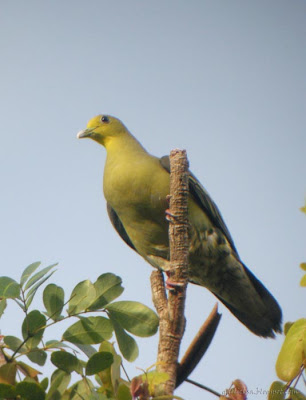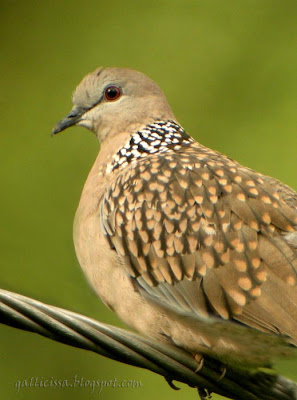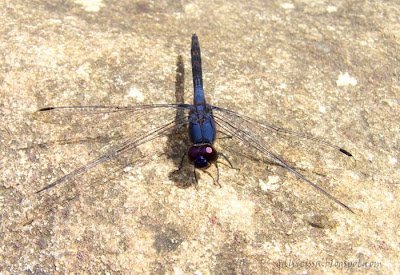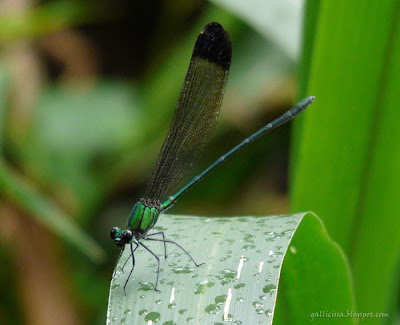
I joined FOGSL’s annual birding pilgrimage to the Peak Wilderness Sanctuary from 20-22 June. This is the only wilderness area in Sri Lanka with attitudinally-graded rain forests ranging from lowland rain forests-up to 1,000m, sub-montane forests from 1,000-1,500m & montane aka cloud forests above 1,500m. These pristine rainforests covering an area of 224 sq.km envelop the Adam’s Peak (2,243m), which is the 4th tallest mountain in Sri Lanka. According to the local Buddhist tradition, a footprint atop this lofty peak is believed to be the foot print of the Buddha. Hindus on the other hand believe it to be their god; Shiva. Other traditions assert that it is the footprint of Adam, left by his first entrance into the world. Net result of all these is this is a pretty important site of pilgrimage in Sri Lanka. It brings together peoples from various faiths in their thousands during the peak pilgrimage season from Dec-April.
FOGSL’s visit to this important bird area (IBA) is done in the off-season to avoid the crowds & chaos. On the previous trip that I took part, we stayed overnight at the ambalama (free lodging shelter) at the Seetha Gangula (colder creek – translation mine) about half way up. This was quite exciting as it made us climb at least half way up towards the Adam’s Peak to earn a warm meal. It is rather cold at night at this camp site. So, we had to lug our sleeping bags & 'stuff'. These ground realities made this annual trip earn a reputation as a tough one out of the calendar of birding trips put together by the FOGSL. And unsurprsingly, the arm-chair birders in us happily eschewed this trip.
Things were different this time. The lodging was arranged at the ambalama at the Palabaddala village, which is a base-camp situated at one of the three main gateways to the summit. We could drive our coach right up to the point where we stayed overnight. This was viewed by many to be a ‘very convenient’ option. We had tasty home cooked meals at a village house nearby with village vegetarian food such as Crape ginger Costus speciosus shoots aka Thebu kola mallung, which we rarely get at home. So there was absolutely no worry of missing out on a warm meal and/or having to do a compulsory survival challenge on day-1. Two new sets of common toilets have been put up for men and women at the site. So, there was absolutely no problem in that department either. There was an ‘almost attached facility’ for ablutions for the lazy types and a dragonfly-infested fast flowing rain forest stream for those prepared to walk for 5 minutes. So, that department was also very much under control. Our mobiles had signals. So, we could stay in touch with the loved ones. There was electricity at the house we ate at. So, we could charge our mobile phones, camera batteries & laptops after sweet-talking the girl in da house. And if we had really pushed, we could have even downloaded our e-mails and checked the feeds of our favourite blogs using their fixed-line telephone. There was also a TV at the house. So, some of us could watch our favourite soaps & have our daily dosage of news. At the end all these spoils coalesced to give this year’s Peak wilderness trip the essence of a full board holiday in a fine nature resort! And it positively exposed the peak dodgers of the group.
The weather during the daytime was a mix of sunny, overcast & rainy - often heavy, with no particular order. Spoiled by the luxuries of our nature resort, swayed by the fickle nature of rain forest weather & tempted by the riches within easy reach, I decided to stick to the verdant lowland forest patches instead of scaling too far up along the well-trodden steps leading to the Adam’s Peak.
Birding highlights:
White-faced Starling Sturnia albofrontata -- After a few 'heard only' records, I was able to scope two individuals of this scarce endemic to give all the participants with excellent views, which proved to be a lifer for some. I observed one individual peeking into cobwebs high up in a tree. The same behaviour was observed by me in Sinharaja in December, 2007. I couldn't see clearly whether it was to drink dew drops off them or to prey on the any occupants. I will keep an eye on this to ascertain this in the future.
 Sri Lanka Myna Gracula ptilogenys -- A vocal pair was observed well in an alien-invasive; Deviltree Alstonia macrophylla . This tree is known in Sri Lanka as Havari-nuga meaning 'wig banyan', because of its distinct pendulous casings of its dry fruits, which look like a woman's long wig. I observed one of the individuals flying away with these long 'wigs'. Since it is a tree-hole nester as shown in this picture taken on a previous tour, this may be nesting material to cushion their nest holes; indicating breeding activity.
Sri Lanka Myna Gracula ptilogenys -- A vocal pair was observed well in an alien-invasive; Deviltree Alstonia macrophylla . This tree is known in Sri Lanka as Havari-nuga meaning 'wig banyan', because of its distinct pendulous casings of its dry fruits, which look like a woman's long wig. I observed one of the individuals flying away with these long 'wigs'. Since it is a tree-hole nester as shown in this picture taken on a previous tour, this may be nesting material to cushion their nest holes; indicating breeding activity.
 Sri Lanka Green Pigeon Treron pompadora – Regular sightings especially in a fruiting fig tree.
Sri Lanka Green Pigeon Treron pompadora – Regular sightings especially in a fruiting fig tree.
 Spotted Dove Streptopelia chinensis -- A common bird found in open & dry patches.
Spotted Dove Streptopelia chinensis -- A common bird found in open & dry patches.
 Other birding highlight included Green Imperiel Pigeon, Yellow-fronted Barbet,Sri Lanka Small Barbet, Orange-billed Babbler, Square-tailed Black Bulbul, Black-capped Bulbul, Yellow-browed Bulbul, Orange Minivet, Sri Lanka Crested Drongo, Black Eagle, Southern Hill-Myna, Crested Serpent Eagle, Oriental Honey Buzzard, Black-headed Cuckoo-shrike, Tawny-bellied Babbler & Indian Swiftlet.
Other birding highlight included Green Imperiel Pigeon, Yellow-fronted Barbet,Sri Lanka Small Barbet, Orange-billed Babbler, Square-tailed Black Bulbul, Black-capped Bulbul, Yellow-browed Bulbul, Orange Minivet, Sri Lanka Crested Drongo, Black Eagle, Southern Hill-Myna, Crested Serpent Eagle, Oriental Honey Buzzard, Black-headed Cuckoo-shrike, Tawny-bellied Babbler & Indian Swiftlet.
Dragonflies & damselflies:
When I labelled the following and sent them to my Slovenian Odonata mentor; Matjaž Bedjanič, he got back to me with a moral boosting line reading “…Your determination skills are very good so I didn't have much to add”.
Asian Skimmer Orthetrum glaucum -- The common name sounds like a racist euphemism that Geoge Carlin would have taken the mickey out of. We encountered this Libelluid a few times along the open trails close to water. The picture below is of a male.
 Indigo Dropwing Trithemis festiva --This was found actively flying around the fast flowing stream at midday. It often settled on the exposed rocks in the stream to oblige for me.
Indigo Dropwing Trithemis festiva --This was found actively flying around the fast flowing stream at midday. It often settled on the exposed rocks in the stream to oblige for me.

Wall's Grappletail Heliogomphus walli --This endemic Clubtail was a lifer for me. It was found in the edge of the forest close to shallow steam that was bordering a tea field.

Shining Gossamerwing Euphaea splendens -- A truly gorgeous damsel that frequents streams & lures passerbys with flashes of iridescence.

Dark-glittering Threadtail Elattoneura centralis -- Found sharing the same riverine habitat with the Black-tipped Flashwings & the above.
Black-tipped Flashwing Vestalis apicalis nigrescens --This fine looking adult male was associating a few old ladies in a shallow stream.

Black-tipped Flashwing Vestalis apicalis nigrescens -- Adult females of this pretty damsel is just like the male shown above but without the black tips to the wings. Like many other females, they get obsessed with gold when they grow older and wears gold - going for that rich look.
More fetching ladies this time of Butterflies:
Cruiser Vindula erota --This is simply an elegant lady. Sightings of her is quite rare. No wonder Bernard D'Abrera wrote this about it in his Sri Lankan butterfly book "Whilst the males are shy and thus not so visible, the sighting of the female in flight always causes my mouth to go dry and my reflexes to become confused". No wonder its species name is erota! This individual frequented a patch of shrubs in the middle of a tea field when we found it. This picture shows it while resting on an alien-invasive; Clidemia hirta plant. The male was photographed by me previously and you can see it here.
Sri Lanka Birdwing Troides darsius -- The female form captured in the picure below is the largest butterfly in Sri Lanka although some dry season forms of the female Blue Mormons in the dry zone in Sri Lanka can rival its size in the wing area. This enigmatic forest lady descended like an angle to a shrub of Mussanda frondosa in search of nectar, when I was alone in a spot. It was an orgasmic sighting! It didn't linger on for too long in one spot and soon melted away into the greenery making my day.
So here's a yet another euphemism explained:
Peak dodger 1. A lazy person who doesn't like uphill walks. e.g. My husband is a typical peak dodger and went golfing. So, I went hiking up to the cloud forest with the resort guide. 2*. A smart naturalist who eschews climbing up to forested peaks during awful weather and explores the forested lowlands in search of familiar pleasures. e.g. It was cloudy when were about to start our climb. Luckily our guide was a peak dodger and we did a great alternate walk just before the rains and saw loads of birds in real quick time!! 3. slang An extremely selfish person who suppresses knowledge of birding/ natural history to other people - especially to tour guides/naturalists, paranoid that they will overshadow him/her one day/earn a living out of it. e.g. That lepidopterist in Sri Lanka is a dead-set peak dodger! He thinks the whole world revolves around him!
The above post is my contribution to IATB #80 hosted at The Hawk Owl's Nest
To visit the IATB HQ click on the logo below



























18 comments:
Yes i can see the similarities.
Again you surprise me and thank you for all the information. I love nature but I am a mathematical in nature and do not like those Latin names. ;)
Hi ST,
With meaning-no:2 I hope!!
Hi Kalusudda,
Thanks! You fall safely within
'normal' nature enthusiasts!
There are far too many vernaculars to refer to one species nowadays due to 'various schools of thoughts'and other reasons. This is worst when it comes to snakes in Sri Lanka with some species having over dozen of names in various parts!
So Latin names help to simlify things for the keener nature enthusiast. They are used in this blog just like a guiding light in case if you run into a cloud of confusing array of synonyms. They can always be ignored as they are almost always in italics.
I envy the dragonflies you get to see...
Great post Amila!
Hi Mel,
Long time no see. Thanks for dropping by. I bet your local lagoon area has some good ones too.
Your odonata has me green with envy Amila, the Orthetrum glaucum is very similar to our O. caledonicum.
Hi Duncan,
Thanks! I remember seeing some good Odonata pics in your blog. Had a look at your O.caledonicum and it indeed looks like our O.glaucum.
I love your odonate photos. The indigo dropwing is beautiful. Do you have dawn dropwing (Trithemis aurora) in Sri Lanka? The males are electric pink. We tried to fly them in our butterfly exhibit some years ago. The adults never lived long enough to develop their pink color :-(
I always wanted to try Euphaea splendens. A relative, Calopteryx maculata, from the States does do well on exhibit, and I think this species might, as well. It would be stunning.
Thanks for sharing such wonderful images.
Very informative and stunning pictures Amila.
Hi Doug,
I commented on your excellent COTS #34 and got back to see that you have been here!
Yes, we do have Dawn Dropwing Trithemis aurora. The males are at the extreme end of the gaudy index. Just had a look at your Calopteryx maculata and yes it does look very similar to our Euphaea splendens.
I have some decent shots of the latter and I will feature them in a future post.
I am keen to see pics of your exhibit and their occupants.
I am sure you will enjoy the post that I am going to publish in 5 hours time.
Hi Indrani!
I plan to be less informative on the next post and you know what I mean...!
Hi Amila! I love that first picture! Such a beautiful scene. This post is absolutely wonderful! So much information and I love all the birds and different dragons you have there.
Hi Lin,
Thanks a lot! I am glad you liked the first picture. That scene soon changes into a different one as the sun rises and it is a fascinating experience.
I am very happy to hear that you liked this post. I didn't include all the critters photographed on this trip in order to prevent the post from getting ridiculously long
Great pics and made me laugh as well
Thanks Bea! I am pleased to hear that!
Amazingly beautiful photography. Your passion shines through. You are a pleasure to read. :) Happy bird watching.
Hi the wades,
Thanks a lot! Great to hear your comments! You have very interesting blog. I will be back to explore it more.
Happy Independece Day!
And have a super weekend!
Post a Comment